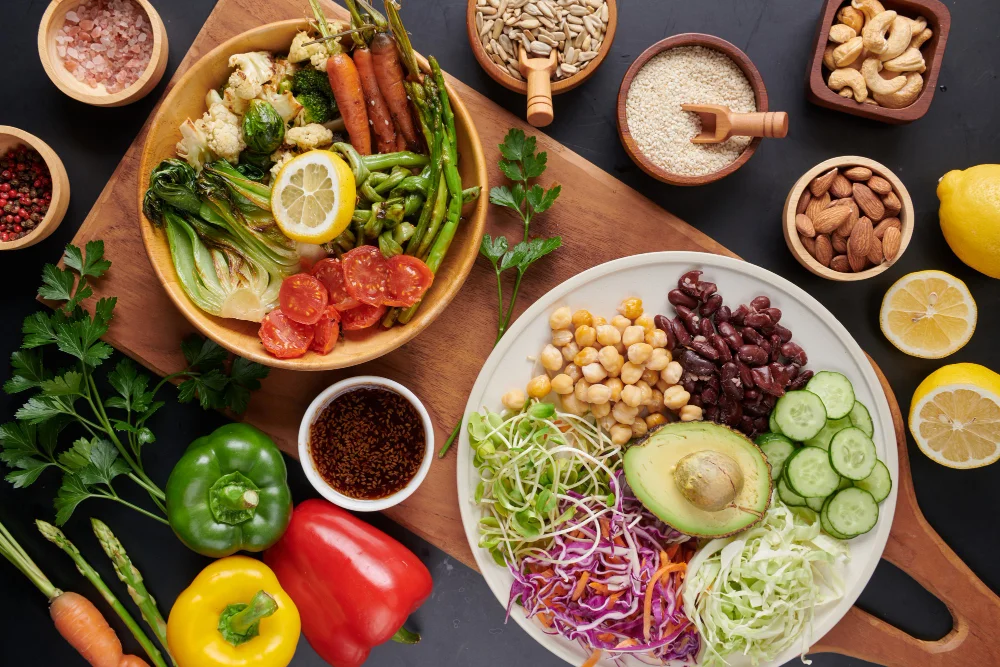Meal planning is often praised as the key to healthier eating—and for good reason. Having a plan can help prevent impulsive food choices, reduce food waste, and make daily mealtimes less stressful. But let’s face it: life is busy, and sticking to a color-coded, Pinterest-worthy meal plan isn’t always realistic.
If you’re trying to eat well without getting overwhelmed, here’s a simpler, more flexible solution—stock your kitchen with nutritious essentials that can serve as building blocks for countless meals. Whether you’re pulling dinner together in 15 minutes or cooking ahead for the week, these pantry, fridge, and freezer staples make healthy eating more attainable.
Here are 15 go-to items nutritionists always keep on hand—and how you can use them to create wholesome meals.
1. Canned Chickpeas: The Versatile Protein Powerhouse
Why nutritionists love it:
Chickpeas are rich in plant-based protein, fiber, and essential nutrients like folate and manganese. One cup provides 14.5g protein and 12.5g fiber—great for satiety and digestion.
How to use it:
- Add to soups, stews, or salads for extra substance
- Mash into chickpea “tuna” wraps with lemon, dill, and celery
- Make chickpea patties, tacos, or a quick hummus dip
Storage tip:
Leftovers keep in the fridge for up to 7 days or can be frozen after drying and flash freezing.
2. Chicken Breast: Lean Protein for Endless Meal Combos
Why nutritionists love it:
Boneless, skinless chicken breast is a lean, high-quality source of complete protein that supports muscle repair and immune function.
How to use it:
- Pair with a whole grain and a veggie for balanced meals
- Stir-fry with broccoli and bell peppers
- Use in soups, pastas, or casseroles
Storage tip:
Freeze raw chicken in portioned packets or store cooked chicken for up to 9 months.
3. Smoked Salmon: Omega-3s Made Easy
Why nutritionists love it:
Smoked salmon is rich in omega-3 fatty acids, which promote heart and brain health. It also contains antioxidants like vitamins A and E.
How to use it:
- Add to wraps, grain bowls, or leafy green salads
- Pair with cream cheese and whole-grain bread
- Toss into a warm pasta dish with lemon and herbs
Storage tip:
Keep leftovers in the fridge for 1 week or freeze for up to 1 month.
4. Extra-Firm Tofu: The Plant-Based Protein Chameleon
Why nutritionists love it:
Tofu is high in protein and calcium, and recent studies suggest it may even help protect against hormone-related cancers.
How to use it:
- Press and pan-fry until crispy for stir-fries
- Add to curries, noodle dishes, or Buddha bowls
- Crumble for plant-based taco filling or scrambles
Storage tip:
Refrigerate for up to 7 days or freeze for up to 6 months.
5. Red Lentils: A Fiber and Protein-Rich Staple
Why nutritionists love it:
Red lentils are nutrient-dense and cook faster than other legumes. They pack 46g of protein per cup (dry) and are great for heart health.
How to use it:
- Make daal, soups, or curry stews
- Add to baked sweet potatoes or grain bowls
- Stir into sautéed greens for a protein boost
Storage tip:
Refrigerate cooked lentils for 5–7 days.
6. Whole Wheat Spaghetti: A Better-for-You Carb
Why nutritionists love it:
Unlike refined pasta, whole wheat spaghetti is a complex carb rich in fiber that helps with digestion and stabilizing blood sugar.
How to use it:
- Toss with jarred or homemade sauces
- Make Mediterranean-style pasta with olives, arugula, and beans
- Use in pasta salads or stir-fries
Storage tip:
Refrigerate cooked spaghetti for 3–5 days; freeze if needed (though texture may change).
7. Quinoa: The Complete Plant-Based Protein Grain
Why nutritionists love it:
Quinoa contains all nine essential amino acids, making it a rare complete protein for a plant food. It’s also rich in magnesium and anti-inflammatory compounds.
How to use it:
- Serve in grain bowls or alongside roasted vegetables
- Add to soups, salads, or casseroles
- Use in place of rice or pasta for added nutrients
Storage tip:
Cooked quinoa stores well in the fridge for up to 1 week.
8. Quick-Cooking Oats: Breakfast Made Better
Why nutritionists love it:
Oats offer beta-glucan, a type of soluble fiber that lowers cholesterol and supports heart health.
How to use it:
- Make a hot breakfast with fruit, seeds, or nut butter
- Add to smoothies for extra fiber
- Use as a binder in meatloaf or muffins
Storage tip:
Store dry oats in a cool, dry place. Add leftover cooked oats to baked goods.
9. Bone Broth: More Than Just Soup
Why nutritionists love it:
Bone broth contains collagen, glucosamine, and chondroitin—nutrients believed to support joint health, digestion, and sleep.
How to use it:
- Cook grains in broth instead of water
- Add to soups, stews, and sauces
- Sip warm with turmeric and black pepper for a healing drink
Storage tip:
Store opened broth in the fridge for up to 5 days or freeze in cubes for later use.
10. Sweet Potatoes: Nutrient-Dense and Naturally Sweet
Why nutritionists love it:
Loaded with potassium, beta-carotene, and soluble fiber, sweet potatoes help regulate blood sugar and support immune health.
How to use it:
- Bake whole or cube and roast
- Add to tacos, pasta, or nourish bowls
- Mash and use in smoothies or baking
Storage tip:
Keep leftovers refrigerated for 3–5 days.
11. Frozen Spinach: Greens Without the Waste
Why nutritionists love it:
Spinach is high in iron, fiber, and antioxidants that promote eye health and oxygen circulation.
How to use it:
- Add to omelets, lasagna, or soups
- Stir into pasta sauces or smoothies
- Use in dips like spinach-artichoke
Storage tip:
Store cooked spinach in the fridge for up to 5 days.
12. Grape Tomatoes: Bite-Sized and Bursting with Antioxidants
Why nutritionists love it:
Tomatoes are rich in lycopene, a powerful antioxidant linked to reduced cancer risk.
How to use it:
- Slice into salads and pastas
- Roast with olive oil and garlic as a flavorful side
- Add raw to sandwiches and grain bowls
Storage tip:
Roast and refrigerate for extended shelf life, or use fresh within 3–5 days.
Final Thoughts: A Smart Kitchen is a Healthy Kitchen
Eating well doesn’t have to mean preparing a seven-day meal plan in advance or cooking from scratch every night. By keeping your pantry, fridge, and freezer stocked with these healthy essentials, you give yourself the flexibility to prepare quick, balanced meals on the fly.
These foods are nutritionist-approved not only for their health benefits but also for their practicality and adaptability. With these items at your fingertips, you’re well on your way to creating a home that supports your wellness goals—one delicious, wholesome meal at a time.














